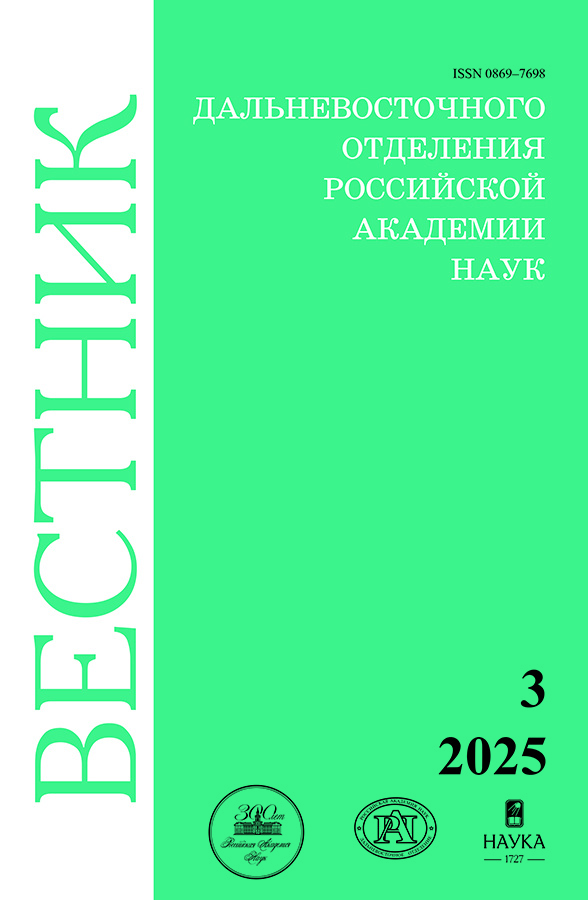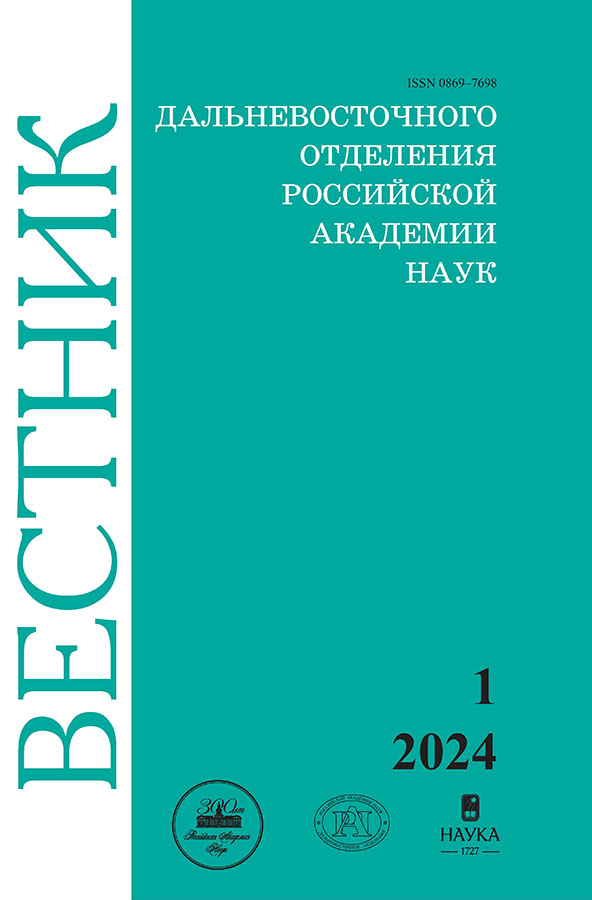Электронный парамагнитный резонанс на примесных ионах меди в трититанате натрия с иерархической двухуровневой архитектурой
- Авторы: Сарицкий Д.А.1, Зиатдинов А.М.1, Железнов В.В.1, Опра Д.П.1, Гнеденков С.В.1
-
Учреждения:
- Институт химии ДВО РАН
- Выпуск: № 1 (2024)
- Страницы: 126-143
- Раздел: Химические науки. Физические методы исследования материалов
- URL: https://permmedjournal.ru/0869-7698/article/view/676055
- DOI: https://doi.org/10.31857/S0869769824010099
- EDN: https://elibrary.ru/leevvq
- ID: 676055
Цитировать
Полный текст
Аннотация
Представлены результаты исследований электронного парамагнитного резонанса на примесных ионах меди в трититанате натрия (Na2Ti3O7) с иерархической двухуровневой архитектурой, потенциально пригодного для использования в качестве отрицательных электродов натрий-ионных аккумуляторов. Основной акцент в работе был сделан на выявление магнитно-неэквивалентных центров примесного иона меди, установление позиций этих центров в кристаллической решетке, определение характера их распределений в объеме образца, а также на выяснение механизмов зарядовой компенсации при алиовалентных замещениях. Для ионов Cu2+ в позициях замещения Ti4+ была оценена делокализация спиновой плотности с нижней атомной орбитали на σ-орбитали ближайших экваториальных ионов кислорода.
Полный текст
Об авторах
Денис Алексеевич Сарицкий
Институт химии ДВО РАН
Email: denissaricki@mail.ru
ORCID iD: 0009-0006-2195-1042
младший научный сотрудник
Россия, ВладивостокАльберт Муктасимович Зиатдинов
Институт химии ДВО РАН
Автор, ответственный за переписку.
Email: ziatdinov@ich.dvo.ru
ORCID iD: 0000-0001-7917-9207
доктор физико-математических наук, главный научный сотрудник, заведующий лабораторией
Россия, ВладивостокВениамин Викторович Железнов
Институт химии ДВО РАН
Email: zhvv53@mail.ru
доктор химических наук, ведущий научный сотрудник
Россия, ВладивостокДенис Павлович Опра
Институт химии ДВО РАН
Email: dp.opra@gmail.com
ORCID iD: 0000-0003-4337-5550
кандидат химических наук, старший научный сотрудник, заведующий лабораторией
Россия, ВладивостокСергей Васильевич Гнеденков
Институт химии ДВО РАН
Email: svg21@hotmail.com
ORCID iD: 0000-0003-1576-8680
член-корреспондент РАН, доктор химических наук, профессор, директор
Россия, ВладивостокСписок литературы
- Xia G., Zhou T., Yu X. (eds.). Hierarchical materials for advanced energy storage. Lausanne: Frontiers Media SA, 2020. 103 p. https://doi.org/10.3389/978-2-88966-185-5.
- Guan M., Wang Q., Zhang X., Bao J., Gong X., Liu Y. Two-dimensional transition metal oxide and hydroxide-based hierarchical architectures for advanced supercapacitor materials // Front. Chem. 2020. Vol. 8. Article number: 390. https://doi.org/10.3389/fchem.2020.00390.
- Jayan J. S., Saritha A., Joseph K. Development of hierarchical nanostructures for energy storage // Advances in nanocomposite materials for environmental and energy harvesting applications / eds A. E. Shalan, A. S. Hamdy Makhlouf, S. Lanceros–Méndez. Cham: Springer, 2022. P. 663–695. (Ser.: Engineering Materials). https://doi.org/10.1007/978-3-030-94319-6_21.
- Chen H., Wu Y., Duan J., Zhan R., Wei Wang W., Wang V.-Q., Chen Y., Xu M., Bao S.-J. (001) Facet-dominated hierarchically hollow Na2Ti3O7 as a high-rate anode material for sodium-ion capacitors // ACS Appl. Mater. Interfaces. 2019. Vol. 11. P. 42197–42205. https://doi.org/10.1021/acsami.9b14560.
- Опра Д. П., Синебрюхов С. Л., Неумоин А. И., Подгорбунский А. Б., Гнеденков С. В. Мезопористые нанотрубчатые материалы на основе Na2Ti3O7 с иерархической архитектурой: синтез и свойства // Изв. вузов. Серия: Химия и хим. технология. 2022. Т. 65, вып. 12. С. 37–43. https://doi.org/10.6060/ivkkt.20226512.6552.
- Wang W., Liu Y., Wu X., Wang J., Fu L., Zhu Y., Wu Y., Liu X. Advances of TiO2 as negative electrode materials for sodium-ion batteries // Adv. Mater. Technol. 2018. Vol. 3, N9. Article number: 1800004. https://doi.org/10.1002/admt.201800004.
- Doeff M. M., Cabana J., Shirpour M. Titanate anodes for sodium-ion batteries // J. Inorg. Organomet. Polym. Mater. 2014. Vol. 24, N1. P. 5–14. https://doi.org/10.1007/s10904-013-9977-8.
- Wang Y., Zhu W., Guerfi A., Kim C., Zaghib K. Roles of Ti in electrode materials for sodium-ion batteries // Front. Energy Res. 2019. Vol. 7. Article number: 1. https://doi.org/10.3389/fenrg.2019.00028.
- Zhang Z., Goodall J. B.M., Brown S., Karlsson L., Clark R. J.H., Hutchison J. L., Rehman I. U., Darr J. A. Continuous hydrothermal synthesis of extensive 2D sodium titanate (Na2Ti3O7) nano-sheets // Dalt. Trans. 2010. Vol. 39. P. 711–714. https://doi.org/10.1039/B915699B.
- An Y., Li Z., Xiang H., Huang Y., Shen J. First-principle calculations for electronic structure and bonding properties in layered Na2Ti3O7 // Open Phys. 2011. Vol. 9. P. 1488–1492. https://doi.org/10.2478/s11534-011-0072-x.
- Vithal M., Rama Krishna, S., Ravi G., Palla S., Velchuri R., Pola S. Synthesis of Cu2+ and Ag+ doped Na2Ti3O7 by a facile ion-exchange method as visible-light-driven photocatalysts // Ceram. Int. 2013. Vol. 39. P. 8429–8439. https://doi.org/10.1016/j.ceramint.2013.04.025.
- Pan H., Lu X., Yu X., Hu Y.-S., Li H., Yang X.-Q., Chen L. Sodium storage and transport properties in layered Na2Ti3O7 for room-temperature sodium-ion batteries // Adv. Energy Mater. 2013. Vol. 3. P. 1186–1194. https://doi.org/10.1002/aenm.201300139.
- Fu S., Ni J., Xu Y., Zhang Q., Li L. Hydrogenation driven conductive Na2Ti3O7 nanoarrays as robust binder-free anodes for sodium-ion batteries // Nano Lett. 2016. Vol. 16. P. 4544–4551. https://doi.org/10.1021/acs.nanolett.6b01805.
- Araújo-Filho A.A., Silva F. L.R., Righi A., da Silva M. B., Silva B. P., Caetano E. W.S., Freire V. N. Structural, electronic and optical properties of monoclinic na2ti3o7 from density functional theory calculations: A comparison with XRD and optical absorption measurements // J. Solid State Chem. 2017. Vol. 250. P. 68–74. https://doi.org/10.1016/j.jssc.2017.03.017.
- Garay-Rodríguez L.F., Murcia-López S., Andreu T., Moctezuma E., Torres-Martínez L.M., Morante J. R. Photocatalytic hydrogen evolution using bi-metallic (Ni/Pt) Na2Ti3O7 whiskers: Effect of the deposition order // Catalysts. 2019. Vol. 9. Article number: 285. https://doi.org/10.3390/catal9030285.
- Opra D. P., Neumoin A. I., Sinebryukhov S. L., Podgorbunsky A. B., Kuryavyi V. G., Mayorov V. Yu., Ustinov A. Yu., Gnedenkov S. V. Moss-like hierarchical architecture self-assembled by ultrathin Na2Ti3O7 nanotubes: Synthesis, electrical conductivity, and electrochemical performance in sodium-ion batteries // Nanomaterials. 2022. Vol. 12. Article number: 1905. https://doi.org/10.3390/nano12111905.
- Опра Д. П., Гнеденков С. В., Синебрюхов С. Л., Подгорбунский А. Б., Соколов А. А., Устинов А. Ю., Курявый В. Г., Майоров В. Ю., Железнов В. В. Легированный марганцем диоксид титана с улучшенными электрохимическими характеристиками для литий-ионных аккумуляторов // Электрохимическая энергетика. 2019. Т. 19, № 3. С. 123–140. https://doi.org/10.18500/1608-4039-2019-19-3-123-140.
- Opra D. P., Gnedenkov S. V., Sinebryukhov S. L., Gerasimenko A. V., Ziatdinov A. M., Sokolov A. A., Podgorbunsky A. B., Ustinov A. Yu., Kuryavyi V. G., Mayorov V. Yu., Tkachenko I. A., Sergienko V. I. Enhancing lithium and sodium storage properties of TiO2(B) nanobelts by doping with nickel and zinc // Nanomaterials. 2021. Vol. 11, N7. Article number: 1703. https://doi.org/10.3390/nano11071703.
- Anh L. T., Rai A. K., Thi T. V. et al. Improving the electrochemical performance of anatase titanium dioxide by vanadium doping as an anode material for lithium-ion batteries // J. Power Sources. 2013. Vol. 243. P. 891–898. https://doi.org/10.1016/j.jpowsour.2013.06.080.
- Opra D. P., Gnedenkov S. V., Sinebryukhov S. L., Podgorbunsky A. B., Sokolov A. A., Ustinov A. Yu., Kuryavyi V. G., Mayorov V. Yu., Zheleznov V. V. Doping of titania with manganese for improving cycling and rate performances in lithium-ion batteries // Chem. Phys. 2020. Vol. 538, N1. Article number: 110864. https://doi.org/10.1016/j.chemphys.2020.110864.
- Sekhar M. C., Reddy B. P., Vattikuti S. V.P. et al. Structural, magnetic, and catalytic properties of Mn-doped titania nanoparticles synthesized by a sol–gel process // J. Cluster Science. 2018. Vol. 29. P. 1255–1267. https://doi.org/10.1007/s10876-018-1437-8.
- Electron paramagnetic resonance of d transition metal compounds. Vol. 16 / F. E. Mabbs, D. Collison (eds). Elsevier: Amsterdam, Netherlands, 1992. 1326 p.
- Жидомиров Г. М., Лебедев Я. С., Добряков С. Н., Штейншнейдер Н. Я., Чирков А. К., Губанов В. А. Интерпретация сложных спектров ЭПР. М.: Наука, 1975. 216 с.
- Ramaswamy V., Bhagwat M., Srinivas D., Ramaswamy A. V. Structural and spectral features of nano-crystalline copper-stabilized zirconia // Catal. Today. 2004. Vol. 97, N1. P. 63–70. https://doi.org/10.1016/j.cattod.2004.06.141.
- Wang Z., Liu Q., Yu J., Wu T., Wang G. Surface structure and catalytic behavior of silica-supported copper catalysts prepared by impregnation and sol–gel methods // Appl. Catal. A: Gen. 2003. Vol. 239. P. 87–94. https://doi.org/10.1016/S0926-860X(02)00421-0.
- Miyamoto S. N., Miyamoto R., Giamello E., Kurisaki T., Hisanobu W. Evaluation of coexistent metal ions with TiO2: an EPR approach // Res. Chem. Intermed. 2018. Vol. 44. P. 4563–4575. https://doi.org/10.1007/s11164–018–3468-z.
- Weil J., Bolton J. R. Electron paramagnetic resonance: Elementary theory and practical applications. 2nd ed. New Jersey: Wiley Interscience, 2007. 688 p.
- Cordoba G., Viniegra V., Fierro J. L.G., Padilla J., Arroyo R. TPR, ESR, and XPS study of Cu2+ ions in sol–gel-derived TiO2 // J. Solid St. Chem. 1998. Vol. 138, N1. P. 1–6. http://dx.doi.org/10.1006/jssc.1997.7690.
- Dudley R. J., Hathaway B. J. Single-crystal electronic and E.S.R. spectra of bis-(aquo)monoacetylacetonatocopper(II) picrate // J. Chem. Soc. A. 1970. P. 1725–1728. http://dx.doi.org/10.1039/J19700001725.
- Billing D. E., Dudley R. J., Hathaway B. J., Tomlinson A. A. G. Single-crystal electronic and electron spin resonance spectra of dichloroaquo-(2,9-dimethyl-l,10-phenanthroline)copper(II) // J. Chem. Soc. A. 1971. P. 691–696. http://dx.doi.org/10.1039/J19710000691.
- Narayana P. A., Sastry K. V.L.N. Core polarization of NH4Br: Cu2+ // J. Chem. Phys. 1972. Vol. 57, N8. P. 3266–3268. https://doi.org/10.1063/1.1678750.
- Garribba E., Micera G. The determination of the geometry of Cu(II) complexes: An EPR spectroscopy experiment // J. Chem. Educ. 2006. Vol. 83. P. 1229–1232. https://doi.org/10.1021/ed083p1229.
- Reyes-Garcia E.A., Sun Y., Reyes-Gil K.R., Raftery D. Solid-state NMR and EPR analysis of carbon-doped titanium dioxide photocatalysts (TiO2-xCx) // Solid State Nucl. Magn. Reson. 2009. Vol. 35. P. 74–81. https://doi.org/10.1016/j.ssnmr.2009.02.004.
- Serwicka E. ESR study on the interaction of water vapour with polycrystalline TiO2 under illumination // Colloids Surf. 1985. Vol. 13, N4. P. 287–293. https://doi.org/10.1016/0166–6622(85)80028–7.
- Yang G., Jiang Z., Shi H., Xiao T., Yan Z. Preparation of highly visible-light active N-doped TiO2 photocatalyst // J. Mater. Chem. 2010. Vol. 20, N25. P. 5301–5309. https://doi.org/10.1039/C0JM00376J.
- Andersson S., Wadsley A. D. The crystal structure of Na2Ti3O7 // Acta Cryst. 1961. Vol. 14. P. 1245–1249. https://doi.org/10.1107/S0365110X61003636.
- Yakubovich O. V., Kireev V. V. Refinement of the crystal structure of Na2Ti3O7 // Crystallogr. Rep. 2003. Vol. 48, N1. P. 24–28. https://doi.org/10.1134/1.1541737.
- Li N., Zhang L., Chen Y., Fang M., Zhang J., Wang H. Highly efficient, irreversible and selective ion exchange property of layered titanate nanostructures // Adv. Funct. Mater. 2012. Vol. 22. P. 835–841. https://doi.org/10.1002/adfm.201102272.
- Umek P., Pregelj M., Gloter A., Cevc P., Jaglicic Z., Ceh M., Pirnat U., Arcon D. Coordination of intercalated Cu2+ sites in copper doped sodium titanate nanotubes and nanoribbons // J. Phys. Chem. C. 2008. Vol. 112. P. 15311–15319. https://doi.org/10.1021/jp805005k.
- Hoffman S. K., Goslar J., Tadyszak K. Electronic structure and dynamics of low symmetry Cu2+ complexes in kainite-type crystal KZnClSO4·3H2O: EPR and ESE studies // J. Magn. Reson. 2010. Vol. 205, N2. P. 293–303. https://doi.org/10.1016/j.jmr.2010.05.014.
- Attanasio D. ESR Study of Bis(ω-nitroacetophenonato)bis(4-methylpyridine)Cu(II): A six-coordinated low-symmetry copper chelate // J. Magn. Reson. 1977. Vol. 26, N1. P. 81–91. https://doi.org/10.1016/0022-2364(77)90237-2.
- Kivelson D., Neiman R. ESR studies on the bonding in copper complexes // J. Chem. Phys. 1961. Vol. 35, N1. P. 149–155. https://doi.org/10.1063/1.1731880.
- Abragam A., Pryce M. H. L. Theory of the nuclear hyperfine structure of paramagnetic resonance spectra in crystals // Proc. R. Soc. Lond. A. 1951. Vol. 205, N1080. P. 135–153. https://doi.org/10.1098/rspa.1951.0022
- Abragam A., Pryce M. H. L. The theory of the nuclear hyperfine structure of paramagnetic resonance spectra in the copper Tutton salts // Proc. R. Soc. Lond. A. 1951. Vol. 206, N1085. P. 164–172. https://doi.org/10.1098/rspa.1951.0062.
- Aswani T., Pushpa Manjari V., Babu B., Muntaz Begum Sk., Rama Sundari G., Ravindranadh K., Ravikumar R. V.S.S.N. Spectral characterizations of undoped and Cu2+ doped CdO nanopowder // J. Mol. Struct. 2014. Vol. 1063. P. 178–183. https://doi.org/10.1016/j.molstruc.2014.01.059.
- Azumi T., Kazuo M. What does the term «Vibronic coupling» mean? // Photochem. Photobiol. 1977. Vol. 25, N3. P. 315–326. https://doi.org/10.1111/j.1751-1097.1977.tb06918.x.
- O’Brien M.C.M. The dynamic Jahn–Teller effect in octahedrally co-ordinated d9 ions // Proc. R. Soc. Lond. A. 1964. Vol. 281, N1386. P. 323–339. https://doi.org/10.1098/rspa.1964.0185.
- Фларри Р. Группы симметрии. Теория и химические приложения: пер. с англ. М.: Мир, 1983. 400 с.
- Ensign T. C., Chang T., Kahn A. H. Hyperfine and nuclear quadrupole interactions in copper-doped TiO2 // Phys. Rev. 1969. Vol. 188, N2. P. 703–709. https://doi.org/10.1103/PhysRev.188.703.
- Dong H. N., Wu S. Y., Li P. Theoretical explanation of EPR parameters for Cu2+ ion in TiO2 crystal // Phys. Stat. Sol. (b). 2004. Vol. 241, N8. P. 1935–1938. https://doi.org/10.1002/pssb.200402033.
Дополнительные файлы











